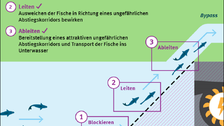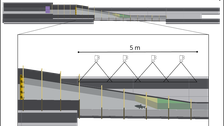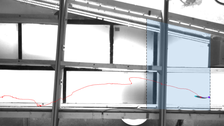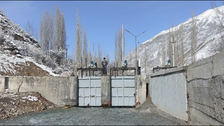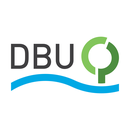Consolidation of the ethohydraulic basis for delay-free fish descent - II
Table of contents
Short Description
Motivation and objectives
The passability of watercourses—both in and against the direction of flow—is one of the most important prerequisites for achieving good ecological status and is required by the Water Resources Act. While there are recognized guidelines for the design of fish ladders among experts, there is a lack of scientifically sound and transferable guidelines, particularly for the hydraulic conditions upstream and downstream of bypass entrances.
With regard to the functions of fish descent systems, namely “blocking,” “guiding,” and “diverting,” there is a particular lack of hydraulic specifications for the “diverting” process in practice.
In the OptiPass project, a threshold value for the parameter spatial velocity gradient (SVG) was defined for the taxonomic group of Cyprinoidei with barbel (Barbus barbus). Based on this, recommendations for the design of bypasses, especially their entry points, were developed to ensure delay-free descent or diversion in the future. Functional fish protection systems thus reduce the negative impact of transverse structures on fish populations. In the follow-up phase, OptiPass II, a further threshold value for the SVG is to be determined for the group of Salmonidae, including brown trout (Salmo trutta).
Methodology
Ethohydraulic laboratory tests are being conducted to determine the SVG threshold value. The bypass at the field site in Shakhimardan (Uzbekistan), which was optimized based on the results from OptiPass Phase I, is to be examined for improved functionality.
Laboratory experiment in the hydraulic lab
The plan is to study fish behavior using video tracking in three experimental setups, initially for one fish species, the brown trout (Salmo trutta) of the taxonomic group Salmonidae. Setup 1 reflects the state of the art and is intended to demonstrate the low utilization rates. Setup 2 serves to ensure uniform SVG characteristics and to derive the threshold value based on escape reactions using statistical algorithms.
In setup 3, the threshold value should not be exceeded in order to demonstrate an improvement in usage rates when the threshold value is adhered to.
The animal experiments are being carried out by our partner IGF.
Field study in Shakhimardan, Uzbekistan
In OptiPass Phase I, an initial field study showed that locally high SVG values also result in low utilization rates in the field. The hydropower plant in Shakhimardan (Uzbekistan), which is funded by the EU project Hydro4U, offered a good opportunity for this thanks to the participation of OptiPass project partner sje. The plant is now to be structurally modified based on the recommendations from the OptiPass project. In OptiPass II, the improved functionality is to be confirmed through monitoring.
Outlook
Finally, the project partners plan to put their findings into practice in the form of planning recommendations.
In OptiPass II, the plan is to develop a planning and optimization tool that takes the defined threshold values into account.
Media

The three basic functions of a fish ladder system that must be fulfilled to protect downstream migrating fish at a hydropower plant. © Ecologic Institut & IGF Jena
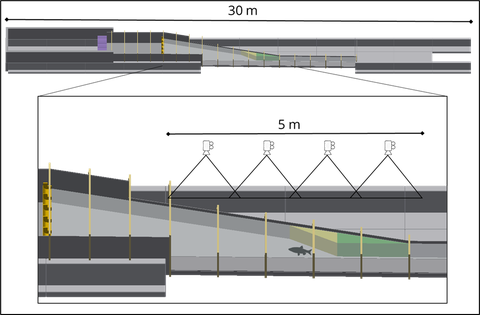
Experimental flume in the hydraulic engineering lab of the TUD, the section shows the observation area in the area in front of and in the bypass entrance, the green installation represents setup 1, the combination of yellow and green installation represen © Konrad Sarodnik

Top view of the swimming path of a barbel in laboratory experiment 7 of setup 1 until it stops in front of the bypass inlet from OptiPass I © Tom Rößger
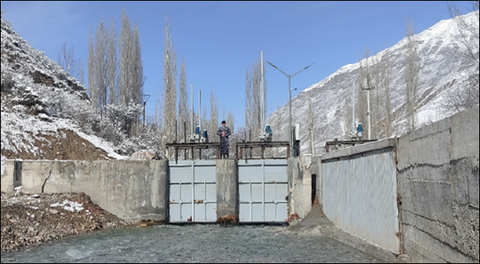
Protective screen and bypass at the Shakhirmardan weir, which is being optimized and investigated as a field site as part of OptiPass. © Erkin Karimov, Projekt Hydro4U
Project Data
|
Website |
|
|
Period |
08/2025 - 08/2026 |
|
Type of Funding |
Third Party |
|
Fundgiver |
German Federal Environmental Foundation (DBU) |
|
TUD Research Priority Areas (RPAs) |
Energy, Mobility and Environment › Water Research |
|
Sustainable Development Goals (SDGs) |
SDG 14 – Life below Water |
|
Keywords |
Fish descent, Bypasses, Ethohydraulics, Physical Modelling |
Project Lead
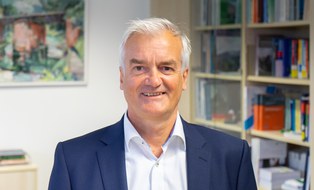 © Andrè Terpe
© Andrè Terpe
Professor
NameMr Prof. Dr.-Ing. Jürgen Stamm
Head of Inst., Chair Hyd. Eng. & School of Civ. & Environ. Eng.
Send encrypted email via the SecureMail portal (for TUD external users only).
Office of the Chair of Hydraulic Engineering
Visiting address:
Beyer-Bau, Room 04-22 George-Bähr-Str. 1
01069 Dresden
Office hours:
Appointments only by prior arrangement (phone or email)
Project Management
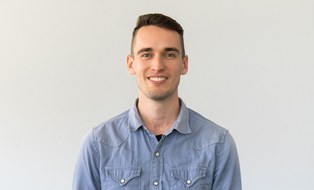 © André Terpe
© André Terpe
Research Associate
NameMr Dipl.-Ing. Tom Rößger
Send encrypted email via the SecureMail portal (for TUD external users only).
Visiting address:
Beyer-Bau, Raum 04-11 George-Bähr-Str. 1
01069 Dresden
Project Partners
|
Partner |
Type |
Website |
|
Institute of Freshwater Ecology and Fisheries Biology Jena (IGF) |
External |
|
|
sje Ecohydraulic Engineering GmbH (SJE) |
External |
Publications
-
Further Information
-
Funding
German Federal Environmental Foundation (Identifier: 40187/01-33/2)


